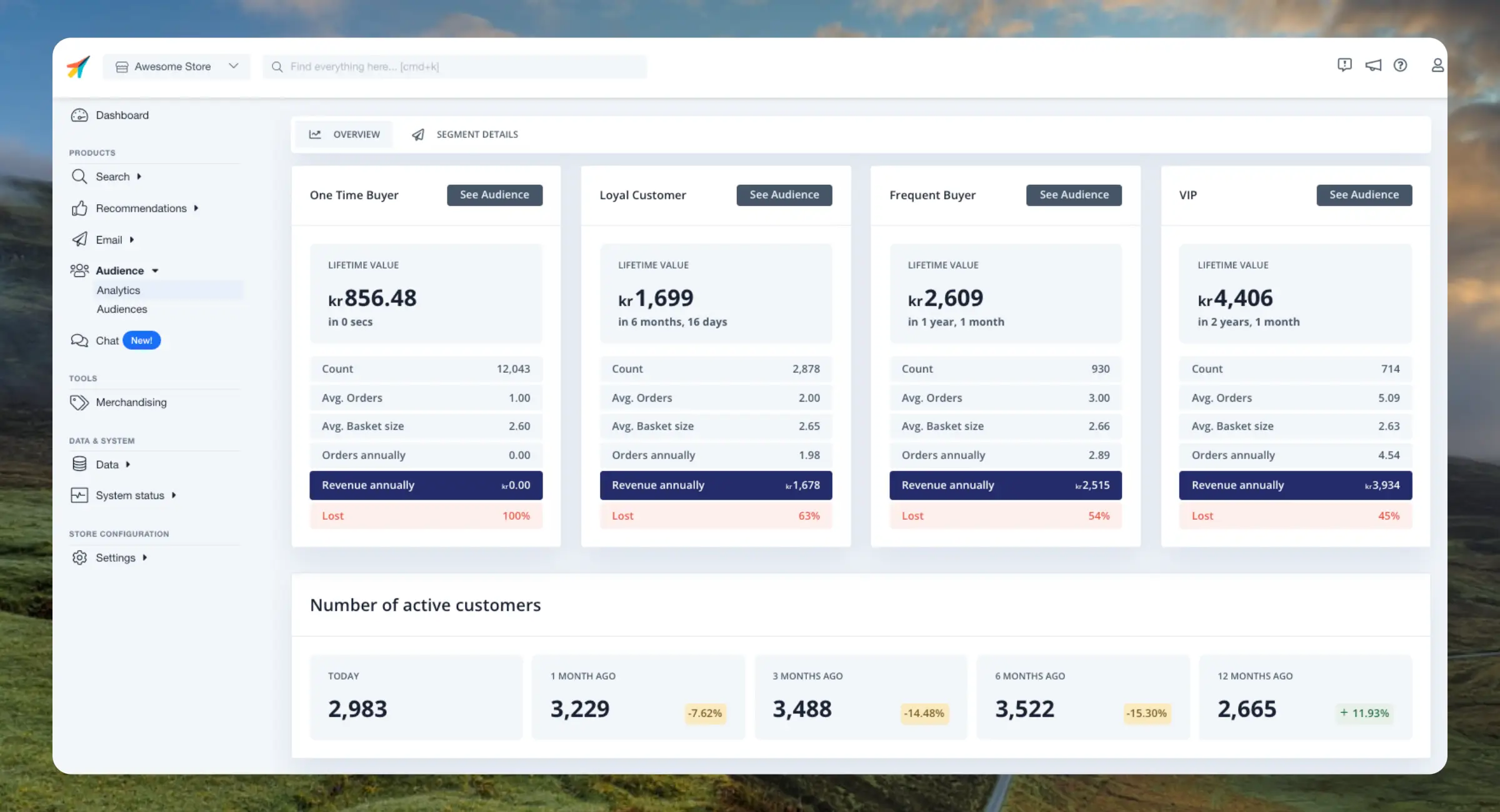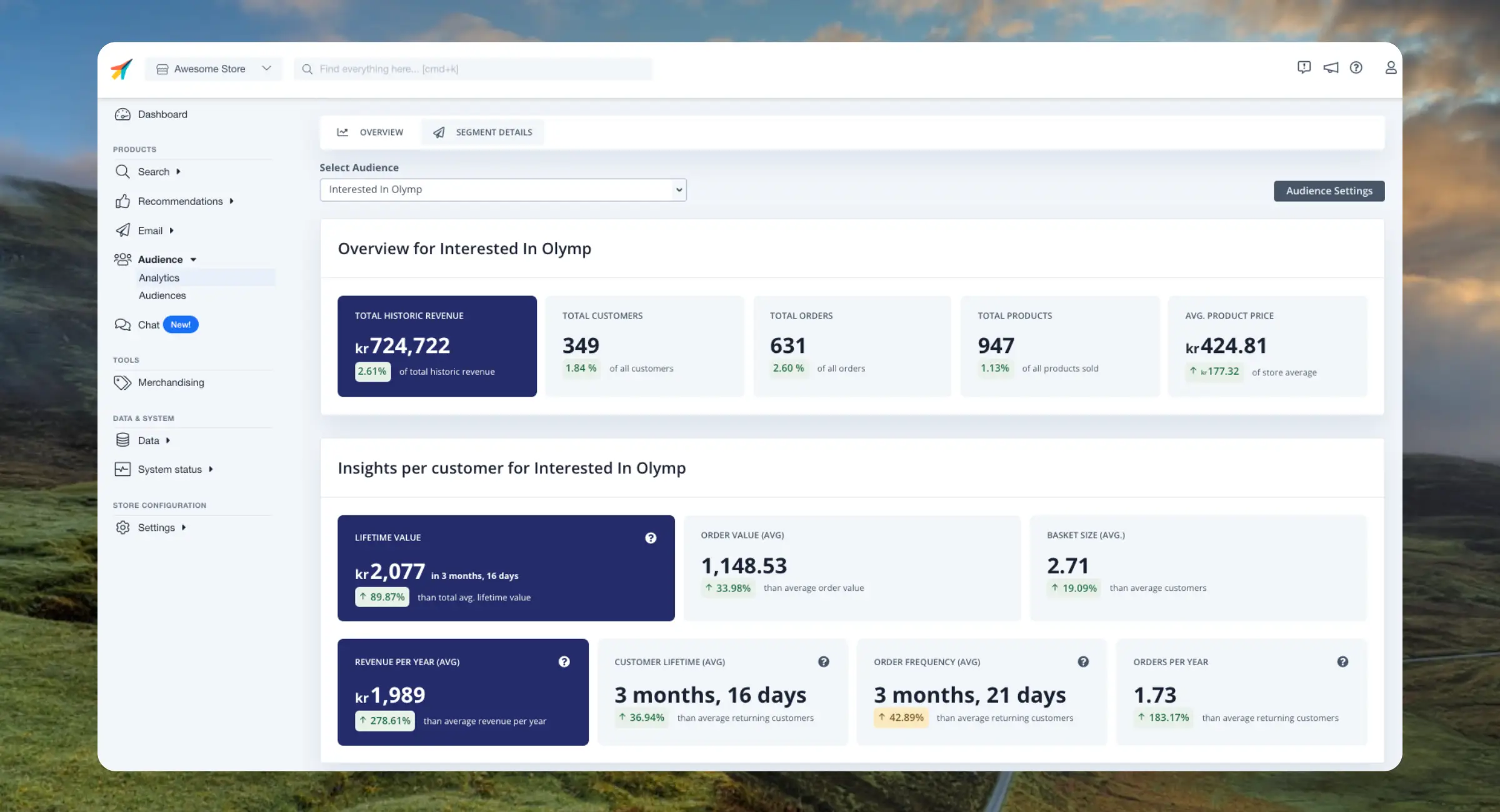Analytics

This dashboard breaks down your customers into groups based on their purchase frequency and life cycle. This helps you identify potential risks of losing customers but also oppurtunities of reactivating customers. Clerk.io
Main Groups #
Customers are divided into 4 groups based on their purchase frequency and the revenue they generate.
These groups are dynamic which means they will change as your customer behaviour changes over time. The groups always reflect the current order history that Clerk has access to.
The groups range from One Time Buyers that have placed a single order over Loyal Customers & Frequent Buyers that purchase regularly, to VIPs who are worth the most to you.
Each group has a number of metrics that are used to define them.
- Lifetime Value: Avg. spend per customer.
- Count: Total number of customer emails or IDs.
- Avg. Orders: Average number of orders before they stop coming back to the site.
- Avg. Basket Size: Average number of products in their orders.
- Annual Orders: Average number of orders placed by each customer per year.
- Annual Revenue: Average revenue generated by each customer per year.
- Lost: Percentage of customers that Clerk predicts will not come back unless reactivated. This is based on how long it’s been since they bought something, compared to how often they normally buy,
Active Customers #
Breaks down the number of customers that purchase regularly on your website today, compared to 1, 3, 6 and 12 months ago.
It shows the total number of Active customers and the change in percentage compared to previous periods.
Clerk defines a customer as Active, if they are purchasing regularly - it doesn’t matter whether they come back every week, month or once a year, as long as they do so consistently.
Customer Base Growth #
The chart further breaks down customers into 4 Lifecycle groups, and shows a bar diagram of their development over time. The default timeframe is All, but it can be narrowed down using the timeframe selector on the right.
- New: Customers that purchased less than 30 days ago.
- Active: Customers that purchase consistently.
- Slipping Away: Customers that purchase less frequently than usual. E.g. if a customer normally buys every month, they will be slipping away after 1,5 months.
- Lost: Customers that have not purchased anything in a long time, compared to their usual behaviour. E.g. if a customer usually buys every month, they will be Lost when its been more than 2 months since their last purchase.
Segment Details #
Also called Customer Analytics, this dashboard gives you an unprecedented overview of each Audience you create. It can be used to compare Audiences and find the one that has the most potential for your marketing campaigns through emails and ads.

Overview #
Shows the base metrics for the Audience in total numbers and as a percentage of the numbers compared to all customers.
- Total Historic Revenue: The all-time earnings from this Audience based on the products they have bought.
- Total Customers: The number of unique email addresses or IDs in this Audience.
- Total Orders: Number of orders placed by the Audience.
- Total Products: Number of products bought by the Audience.
- Avg. Product Price: The average price across all products bought by the Audience.
Insights Per Customer #
Detailed averages and predictions for the Audience. This gives you the insights you need to decide which Audience is most worth your ad spend.
The numbers reflect the averages for each single customer in the Audience.
- Lifetime Value: Estimated earnings from customers until they stop coming back.
- Order Value: Average revenue of the orders placed.
- Basket Size: Average number of products in the orders placed.
- Revenue Per Year: Estimated revenue made each year.
- Customer Lifetime: Estimated amount of time where customers keep coming back to the site.
- Order Frequency: Estimated time between orders.
- Orders Per Year: Average number of orders placed each year.
Most Popular Products #
A list of products that are most frequently bought by this Audience. This can be used to identify the types of products that are best for marketing to these customers.
By default, it’s sorted by the number of times each product has been bought, but it can be re-sorted by clicking any of the metrics.